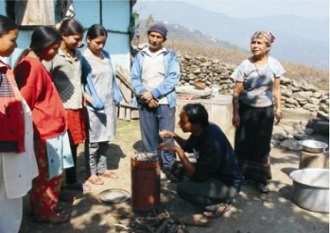Clean Stoves for All
When it comes to fighting global warming, much of the world’s attention has focused on ways to eliminate coal-fired power plants, promote electric vehicles, and build wind farms. But what if there were something far simpler and more low-tech that would have the same benefit as taking more than half the cars in the United States off the road? Well, it turns out there is—which is why everyone from the U.S. Congress to the United Nations and the philanthropic wing of Shell Oil is suddenly talking about cookstoves.
Burning wood or dung in simple stoves or open hearths is the way half the world’s people—the poorer half, in places like India and sub-Saharan Africa—prepare meals and heat homes. For years activists have tried to convert people to more efficient chimney stoves as a way to improve health. (Smoke from indoor fires kills more people each year than malaria or tuberculosis and contributes to childhood pneumonia, the leading cause of death for those under 5, according to the World Health Organization.) But old habits die hard. Plus, cleaner-burning stoves were either too expensive or too unreliable to be attractive to the poorest of the poor.
Scientists, however, have recently begun focusing on black carbon, a component of soot that is produced from burning wood or dung, as an important contributor to global warming. By some estimates, black carbon is far more damaging per ton of emissions than carbon dioxide. Because black carbon stays in the air for just days or weeks—as opposed to the 100 years or more that carbon dioxide remains in the atmosphere—scientists believe tackling it may be the fastest way to mitigate global warming.
About 20 percent of the world’s black-carbon emissions comes from cooking fires (the rest comes primarily from diesel engines and forest or crop fires). Converting most of the world’s poor to more efficient stoves—which still burn solid fuel, just far less of it—would do as much to prevent global warming as taking 134 million cars off the streets, and do so at a fraction of the cost. That’s why building better stoves—and finding a way to persuade the poor to use them—has become a priority.
The energy bill passed by the U.S. Senate in May calls for the government to help distribute stoves. A similar bill passed by the U.S. House of Representatives in 2009 even mandated that 20 million homes be provided with better stoves within five years. The history of cookstoves, however, is one of a succession of well-intentioned failures. India paid tens of millions of dollars to supply stoves to rural villages between 1984 and 2004. But the government stoves were of poor quality and, because they were given away, there was no natural after-market for servicing them. As a result, within a few years the vast majority were no longer in use.
Many, though, think this time will be different. A handful of private companies have decided there is money to be made in stoves, and they are marketing models that are efficient, durable, and priced between $25 and $100. That’s still too costly for many of the world’s poorest. Experts say the price has to drop below $12 for guaranteed widespread adoption. But some are hoping that the growing ranks of microfinance banks will be persuaded to lend money to villagers to bridge this gap, or that Western companies might be persuaded to finance distribution in exchange for carbon-trading credits. The U.N. Foundation also plans to launch a Global Alliance for Clean Cookstoves in September. But it remains unclear whether enough of the world’s poor can be persuaded to change the way they cook in time to keep the entire planet from roasting.
Source: July 24, 2010, http://www.newsweek.com/2010/07/24/clean-stoves-for-all.html



